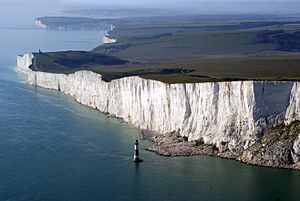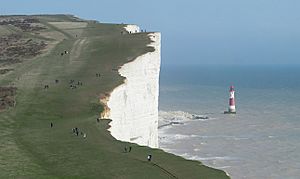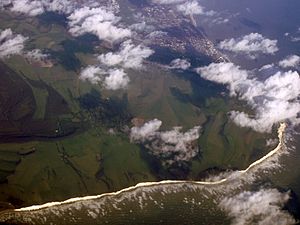Beachy Head facts for kids
Beachy Head is a famous chalk cliff in East Sussex, England. It stands near the town of Eastbourne, just east of another well-known area called the Seven Sisters.
This impressive cliff is part of the land owned by the Eastbourne Borough Council. It is the tallest chalk sea cliff in Britain, reaching about 162 meters (531 feet) above the sea. From the top, you can see far along the coast, from Dungeness in the east to the Isle of Wight in the west.
Contents
How Beachy Head Formed
The chalk that makes up Beachy Head was created a very long time ago, between 66 and 100 million years ago. Back then, this whole area was under the sea! Over millions of years, tiny sea creatures died and their shells settled on the seabed, forming thick layers of chalk.
Later, during the Cenozoic Era, the land was pushed upwards by powerful forces inside the Earth. When the last Ice Age ended, sea levels rose. The rising water then carved out the English Channel and shaped the dramatic cliffs we see today along the Sussex coast.
The sea keeps changing the cliffs. Waves hit the bottom of the cliffs, causing small pieces of rock to fall off often. The chalk is made of layers with bands of flint, which affects how it breaks. When waves wear away the lower parts, large slabs of chalk can break off. This then makes the upper parts of the cliff unstable, and they can collapse too.
One big collapse happened in 2001. After a very rainy winter, water got into cracks in the cliff. When it froze, the water expanded, making the cracks wider. This caused a well-known chalk stack called the Devil's Chimney to break off and fall into the sea.
A Look at Its Past
The name "Beachy Head" might sound like it has something to do with a beach, but it doesn't! The name comes from old French words, beau chef, which mean "beautiful headland." People started calling it Beachy Head consistently by 1724.
In 1929, the town of Eastbourne bought about 4,000 acres of land around Beachy Head. They spent about £100,000 (a lot of money back then!) to protect the area from being built on. This land is now known as the Eastbourne Downland Estate.
Beachy Head has always been an important landmark for sailors. It's even mentioned in an old sea song called Spanish Ladies. Sailors would use it to know where they were along the coast.
Interestingly, the ashes of a famous German thinker named Friedrich Engels were scattered off these cliffs into the English Channel. He was a social scientist and philosopher.
In the 1950s, human remains were found near Beachy Head. Scientists later studied them using special techniques like carbon dating. They discovered the remains belonged to a Roman woman from Sub-Saharan Africa. She had grown up in the Eastbourne area around 200–250 CE. She is now known as Beachy Head Lady.
The Beachy Head Lighthouse
Because Beachy Head is such a prominent point, it has always been a danger to ships. In 1831, a lighthouse called the Belle Tout Lighthouse was built on a nearby headland. However, mist and low clouds often hid its light.
So, the Beachy Head Lighthouse was built right in the sea below Beachy Head. This lighthouse is much closer to the water, making it easier for ships to see its light, even in bad weather.
Beachy Head During Wars
Beachy Head has seen its share of battles.
- In 1653, during the First Anglo-Dutch War, a naval battle called the Battle of Portland took place off Beachy Head.
- Another big naval fight, the Battle of Beachy Head, happened in 1690 during the Nine Years' War.
- During the First World War in September 1916, German U-boats (submarines) sank 30 merchant ships near Beachy Head. This happened despite a huge effort by the Royal Navy to stop them.
In the Second World War, the Royal Air Force (RAF) set up a special radio station at Beachy Head. This helped them talk to their planes better. In 1942, they even picked up TV signals from the Eiffel Tower in Paris! The Germans were using a TV transmitter there, and the RAF monitored the programs, hoping to learn something useful.
The area also had an important radar station during the war. Later, during the Cold War, an underground radar control center was used from 1953 to 1957.
Visiting Beachy Head
Beachy Head is a very popular place for tourists. West of Belle Tout, the cliffs lead to Birling Gap, and then rise again to the famous Seven Sisters.
Visitors can enjoy many walking paths along the cliffs. Birling Gap has a restaurant, and in summer, you can often find ice cream vans there. It's a great place to enjoy the stunning views and fresh sea air.
Beachy Head in Entertainment
Beachy Head's dramatic cliffs and lighthouse have made it a popular spot for films, music videos, and TV shows.
In Films
- In the 1980 film Hopscotch, there's an explosion over the cliffs.
- The 2010 movie Brighton Rock was filmed a lot at Beachy Head.
- Chitty Chitty Bang Bang (1969) shows Chitty falling off the cliff before it flies for the first time.
- Beachy Head was used as the setting for the 1994 Quidditch World Cup in Harry Potter and the Goblet of Fire (2005).
- The opening scene of the 1987 James Bond film The Living Daylights features a car going over the cliff, with Bond parachuting off.
- The area is a key backdrop in the 2012 film Now Is Good.
- The 1964 film The Chalk Garden also uses the area and lighthouse as a backdrop.
In Music Videos
- The cover photo for Throbbing Gristle's 1979 album 20 Jazz Funk Greats was taken at Beachy Head.
- The music video for David Bowie's 1980 song "Ashes to Ashes" was filmed here.
- The Cure used the location for their 1985 music video "Close to Me (The Cure song)".
- Katherine Jenkins filmed her music video for 'Quello Che Faro' here in 2006.
In Television
- Beachy Head is seen in the BBC TV drama Luther.
- It's a key location in an episode of the British series The Prisoner.
- Beachy Head was used in an episode of Black Mirror, "Be Right Back".
- A Monty Python sketch was filmed at Beachy Head.
- Jeremy Clarkson from Top Gear did a tribute for the Jaguar E Type on Beachy Head.
In Technology
- A photo of Beachy Head was even used as a desktop wallpaper on Windows 7 computers!
Images for kids
See also
 In Spanish: Cabo Beachy para niños
In Spanish: Cabo Beachy para niños





